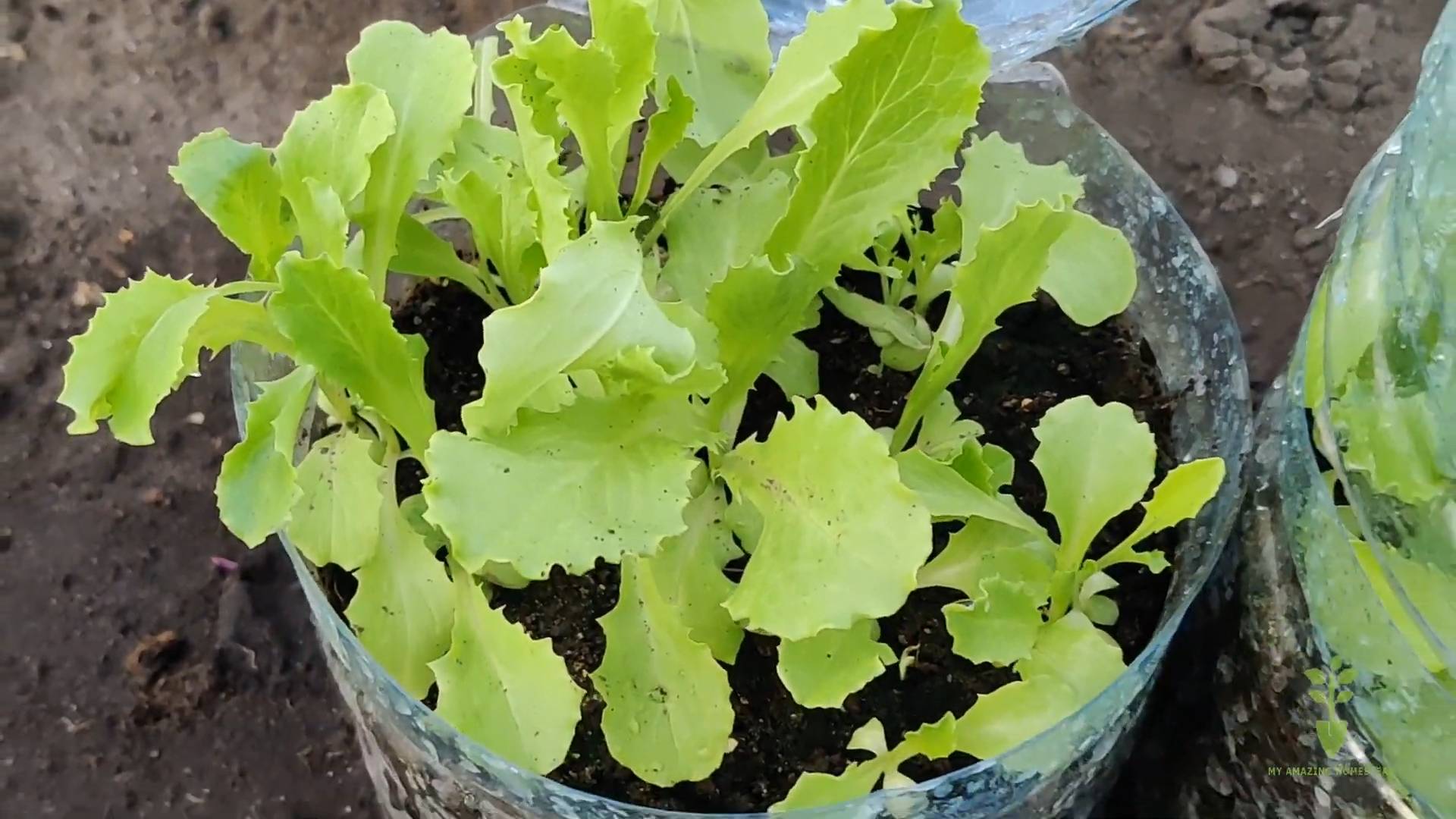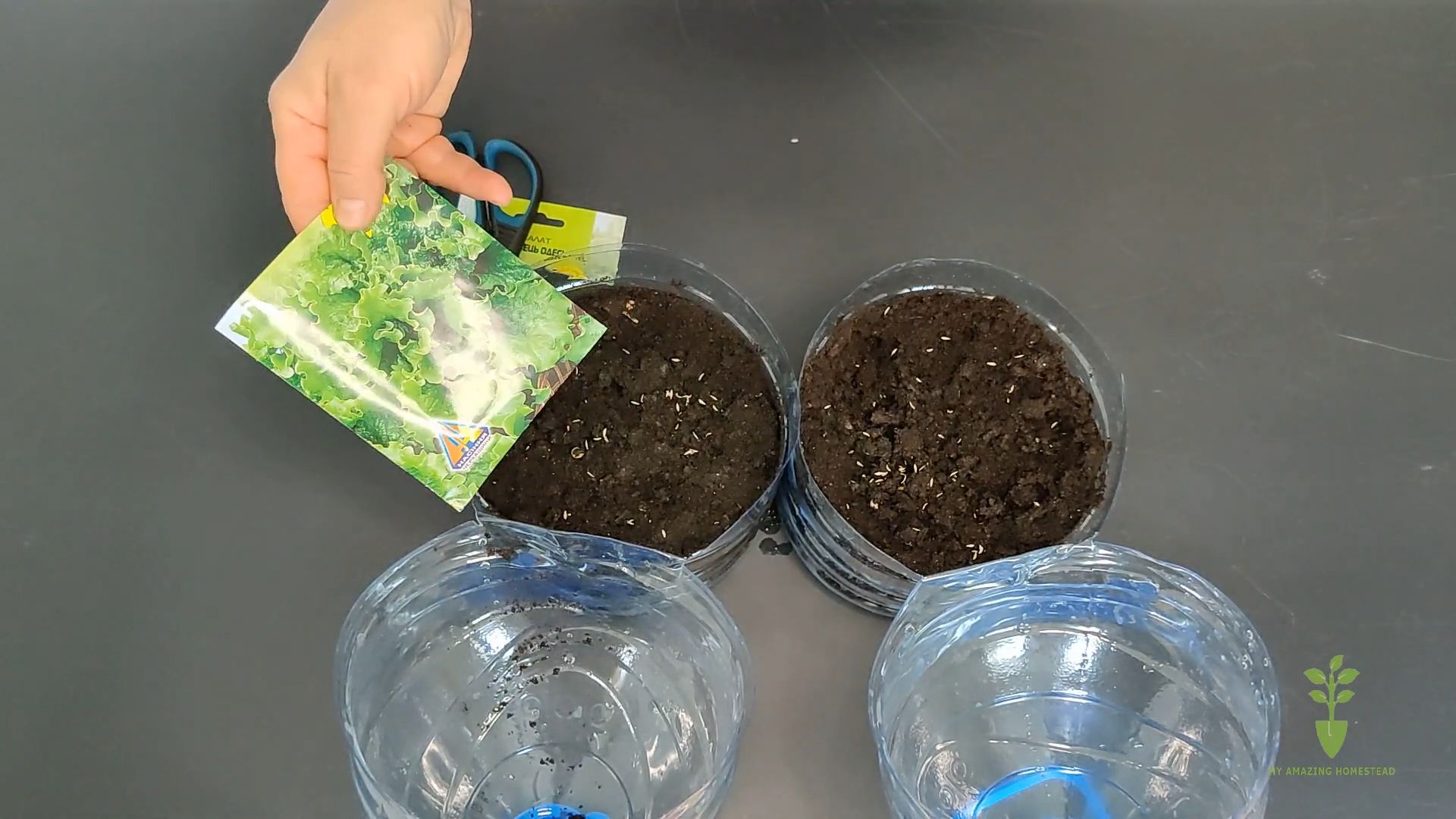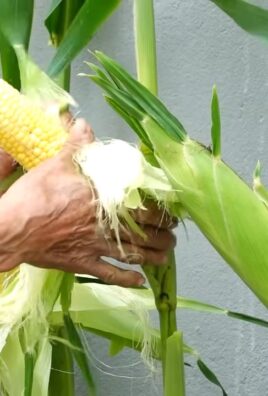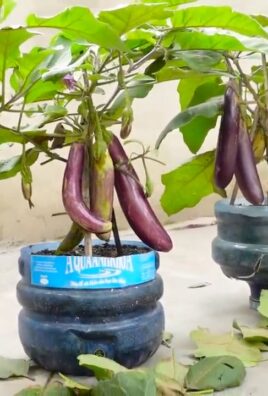Grow Lettuce at Home, and you’ll unlock a world of fresh, crisp salads right at your fingertips! Forget those wilted, overpriced greens from the grocery store. Imagine stepping into your backyard or onto your balcony and harvesting vibrant, flavorful lettuce whenever you crave a healthy meal.
For centuries, cultivating lettuce in home gardens has been a cherished tradition. From ancient Egyptians who considered it sacred to Roman emperors who enjoyed it as a delicacy, lettuce has always held a special place in our diets. Today, with concerns about food miles and the desire for organic produce, the appeal of growing your own lettuce is stronger than ever.
But let’s be honest, sometimes gardening can feel a bit daunting, right? That’s where these simple DIY tricks and hacks come in! I’m going to share some easy-to-follow tips that will help you successfully grow lettuce at home, even if you’re a complete beginner. We’ll cover everything from choosing the right varieties and preparing your soil to preventing pests and harvesting your bounty. Get ready to enjoy the satisfaction of nurturing your own food and savoring the delicious taste of homegrown lettuce!

Grow Your Own Delicious Lettuce: A Beginner’s Guide
Hey there, fellow gardening enthusiasts! I’m so excited to share my tried-and-true method for growing lettuce right at home. Forget those sad, wilted heads at the grocery store – fresh, crisp lettuce is just a few steps away, and trust me, it’s incredibly rewarding. This guide will walk you through everything you need to know, from choosing the right lettuce variety to harvesting your bounty. Let’s get started!
Choosing Your Lettuce Variety
Before we dive into the nitty-gritty, let’s talk lettuce types. There’s a whole world beyond iceberg, and each variety has its own unique flavor and texture. Here’s a quick rundown to help you decide:
* **Loose-leaf Lettuce:** This is the easiest type to grow and harvest. The leaves grow in a loose bunch, and you can snip off individual leaves as needed, allowing the plant to keep producing. Popular varieties include Black Seeded Simpson, Red Sails, and Oakleaf.
* **Butterhead Lettuce:** Known for its soft, buttery texture and delicate flavor. These form loose heads. Look for varieties like Buttercrunch and Bibb.
* **Romaine Lettuce:** This is the classic choice for Caesar salads. Romaine forms tall, upright heads with crisp, sturdy leaves. Try varieties like Parris Island Cos or Jericho.
* **Crisphead Lettuce:** This is your classic iceberg lettuce. While it’s the most challenging to grow, it’s definitely doable with a little patience. Great Lakes is a popular variety.
I personally recommend starting with loose-leaf lettuce. It’s the most forgiving and provides a continuous harvest.
Gathering Your Supplies
Okay, now that you’ve chosen your lettuce, let’s gather our supplies. You’ll need:
* **Lettuce Seeds:** Choose your favorite variety!
* **Seed Starting Trays or Small Pots:** These will be used to start your seeds indoors (optional, but recommended).
* **Seed Starting Mix:** A light, well-draining mix specifically designed for starting seeds.
* **Potting Soil:** For transplanting your seedlings into larger containers or directly into the garden.
* **Gardening Gloves:** To keep your hands clean.
* **Watering Can or Spray Bottle:** For gentle watering.
* **Fertilizer (Optional):** A balanced, water-soluble fertilizer can help boost growth.
* **Garden Trowel:** For transplanting.
* **Location:** A spot in your garden that receives at least 6 hours of sunlight per day. Lettuce can tolerate some shade, especially in hotter climates.
* **Containers (Optional):** If you’re growing in containers, choose pots that are at least 6 inches deep.
Starting Your Seeds (Optional but Recommended)
Starting your seeds indoors gives you a head start on the growing season, especially if you live in a cooler climate. Here’s how I do it:
1. **Fill Your Trays or Pots:** Fill your seed starting trays or small pots with seed starting mix. Gently tap the trays to settle the soil.
2. **Sow the Seeds:** Sprinkle a few lettuce seeds on top of the soil in each cell or pot. Lettuce seeds are tiny, so don’t bury them too deep.
3. **Cover Lightly:** Cover the seeds with a very thin layer of seed starting mix.
4. **Water Gently:** Use a spray bottle to gently moisten the soil. Avoid overwatering, as this can cause the seeds to rot.
5. **Provide Light:** Place the trays or pots in a bright, sunny location or under grow lights.
6. **Keep Moist:** Keep the soil consistently moist, but not soggy. You can cover the trays with a clear plastic dome or plastic wrap to help retain moisture.
7. **Germination:** Lettuce seeds typically germinate in 7-10 days.
8. **Thin Seedlings:** Once the seedlings have their first true leaves (the second set of leaves), thin them out so that only one strong seedling remains in each cell or pot.
Transplanting Your Seedlings (or Direct Sowing)
Once your seedlings have developed a few sets of true leaves and are about 2-3 inches tall, they’re ready to be transplanted into your garden or larger containers. If you’re skipping the seed starting step, you can direct sow the seeds directly into the garden.
Transplanting Seedlings:
1. **Prepare the Soil:** Choose a location in your garden that receives at least 6 hours of sunlight per day. Lettuce prefers well-drained soil that is rich in organic matter. Amend the soil with compost or other organic matter if needed.
2. **Dig Holes:** Dig holes that are slightly larger than the root balls of your seedlings. Space the holes about 6-8 inches apart for loose-leaf lettuce and 10-12 inches apart for head lettuce.
3. **Gently Remove Seedlings:** Carefully remove the seedlings from their trays or pots. Be gentle to avoid damaging the roots.
4. **Place Seedlings in Holes:** Place the seedlings in the holes, making sure that the top of the root ball is level with the surrounding soil.
5. **Fill with Soil:** Fill the holes with soil and gently firm the soil around the seedlings.
6. **Water Thoroughly:** Water the seedlings thoroughly after transplanting.
Direct Sowing:
1. **Prepare the Soil:** As with transplanting, choose a sunny location with well-drained soil.
2. **Create Rows or Beds:** Create shallow rows or beds in the soil.
3. **Sow Seeds:** Sprinkle the lettuce seeds thinly along the rows or beds.
4. **Cover Lightly:** Cover the seeds with a very thin layer of soil.
5. **Water Gently:** Water the soil gently to avoid washing away the seeds.
6. **Thin Seedlings:** Once the seedlings emerge, thin them out to the appropriate spacing (6-8 inches for loose-leaf, 10-12 inches for head lettuce).
Caring for Your Lettuce
Now that your lettuce is planted, it’s time to provide it with the care it needs to thrive.
* **Watering:** Lettuce needs consistent moisture to grow well. Water regularly, especially during hot, dry weather. Aim to keep the soil consistently moist, but not soggy. Water in the morning to allow the leaves to dry before nightfall, which can help prevent fungal diseases.
* **Fertilizing (Optional):** If you want to give your lettuce a boost, you can fertilize it with a balanced, water-soluble fertilizer every few weeks. Follow the instructions on the fertilizer package.
* **Weeding:** Keep the area around your lettuce free of weeds. Weeds can compete with your lettuce for water and nutrients.
* **Pest Control:** Lettuce is generally pest-resistant, but it can be susceptible to aphids, slugs, and snails. Inspect your plants regularly for pests and take action if necessary. You can use insecticidal soap or diatomaceous earth to control aphids. For slugs and snails, you can use beer traps or handpick them off the plants.
* **Bolting:** Bolting is when lettuce plants send up a flower stalk and the leaves become bitter. This is usually triggered by hot weather. To prevent bolting, plant lettuce in a location that receives some shade during the hottest part of the day. You can also choose heat-tolerant varieties. If your lettuce does start to bolt, harvest it immediately.
Harvesting Your Lettuce
The best part! Harvesting your own lettuce is so satisfying.
* **Loose-leaf Lettuce:** You can start harvesting loose-leaf lettuce as soon as the leaves are large enough to eat. Simply snip off the outer leaves with scissors or a knife, leaving the inner leaves to continue growing. This allows you to harvest lettuce continuously for several weeks.
* **Butterhead and Romaine Lettuce:** Harvest these types of lettuce when the heads are firm and well-formed. Cut the head off at the base of the plant.
* **Crisphead Lettuce:** Harvest crisphead lettuce when the heads are firm and dense. Cut the head off at the base of the plant.
I love harvesting my lettuce in the morning, when the leaves are crisp and cool.
Troubleshooting
Even with the best care, you might encounter a few challenges along the way. Here are some common problems and how to address them:
* **Yellowing Leaves:** This can be caused by overwatering, underwatering, or nutrient deficiencies. Check the soil moisture and adjust your watering accordingly. If you suspect a nutrient deficiency, fertilize your lettuce with a balanced fertilizer.
* **Aphids:** These tiny pests can suck the sap from lettuce leaves, causing them to become distorted and yellow. Spray the plants with insecticidal soap or neem oil.
* **Slugs and Snails:** These pests can chew holes in lettuce leaves. Use beer traps or handpick them off the plants.
* **Bolting:** As mentioned earlier, bolting is when lettuce plants send up a flower stalk and the leaves become bitter. Plant lettuce in a location that receives some shade during

Conclusion
So, there you have it! Growing lettuce at home is not only achievable, but it’s also incredibly rewarding. Forget those limp, pre-packaged greens from the grocery store. Imagine stepping out into your garden, balcony, or even just to a sunny windowsill, and harvesting crisp, vibrant lettuce leaves bursting with flavor. This DIY trick transforms the way you think about fresh produce, putting control back into your hands and offering a sustainable, cost-effective alternative to store-bought options.
Why is this a must-try? Because it’s simple, space-saving, and delivers unparalleled freshness. You’ll be amazed at how quickly your lettuce sprouts and matures, providing a continuous supply of salad greens for weeks, even months, depending on the variety and your growing conditions. Plus, there’s something deeply satisfying about nurturing a plant from seed to table. It connects you to the natural world and provides a tangible sense of accomplishment.
But the benefits don’t stop there. Growing your own lettuce allows you to experiment with different varieties. Tired of iceberg? Try romaine, butterhead, or even a spicy mesclun mix. You can also control the growing environment, ensuring your lettuce is free from harmful pesticides and herbicides. This is especially important if you’re concerned about the health and well-being of your family.
Looking for variations? Consider succession planting. Sow new seeds every few weeks to ensure a continuous harvest throughout the growing season. You can also try growing lettuce indoors during the colder months, using grow lights to supplement natural sunlight. Another fun variation is to grow lettuce in containers of different sizes and shapes, adding a touch of greenery and visual interest to your space. Vertical gardening is also a great option for those with limited space.
Don’t be intimidated if you’ve never grown anything before. Lettuce is one of the easiest vegetables to cultivate, making it perfect for beginners. With a little bit of sunlight, water, and care, you’ll be enjoying fresh, homegrown lettuce in no time.
We wholeheartedly encourage you to give this DIY trick a try. It’s a game-changer for anyone who loves fresh, healthy food. Once you experience the joy of harvesting your own lettuce, you’ll never go back to store-bought again.
And most importantly, we want to hear about your experience! Share your photos, tips, and challenges in the comments below. Let us know what varieties you’re growing, what growing methods you’re using, and any secrets you’ve discovered along the way. Together, we can create a community of home gardeners who are passionate about growing their own food. So, get your hands dirty, plant some seeds, and start enjoying the delicious rewards of growing lettuce at home!
FAQ
What kind of lettuce is easiest to grow at home?
Loose-leaf varieties like Black Seeded Simpson, Salad Bowl, and Red Sails are generally considered the easiest for beginners. They mature quickly, are relatively tolerant of different growing conditions, and you can harvest individual leaves as needed, rather than waiting for the entire head to mature. Romaine and butterhead varieties are also relatively easy to grow, but they may require a bit more attention to watering and fertilization.
How much sunlight does lettuce need?
Lettuce needs at least 4-6 hours of sunlight per day. However, it can tolerate partial shade, especially during the hottest part of the day. If you’re growing lettuce indoors, you’ll likely need to supplement natural sunlight with grow lights to ensure adequate growth.
What kind of soil is best for growing lettuce?
Lettuce prefers well-drained, fertile soil that is rich in organic matter. A slightly acidic to neutral pH (around 6.0 to 7.0) is ideal. You can amend your soil with compost, aged manure, or other organic materials to improve its fertility and drainage. If you’re growing lettuce in containers, use a high-quality potting mix specifically formulated for vegetables.
How often should I water my lettuce?
Lettuce needs consistent moisture to thrive. Water deeply whenever the top inch of soil feels dry to the touch. Avoid overwatering, as this can lead to root rot. During hot weather, you may need to water more frequently. Mulching around your lettuce plants can help to retain moisture in the soil.
How do I harvest lettuce?
For loose-leaf varieties, you can harvest individual leaves as needed, starting with the outer leaves. Simply snip them off at the base of the plant. For head lettuce varieties, wait until the head is firm and well-formed before harvesting. Cut the head off at the base of the plant with a sharp knife.
What are some common pests and diseases that affect lettuce?
Common pests that affect lettuce include aphids, slugs, snails, and cutworms. You can control these pests with organic methods such as hand-picking, using insecticidal soap, or applying diatomaceous earth. Common diseases that affect lettuce include downy mildew, powdery mildew, and bottom rot. You can prevent these diseases by providing good air circulation, avoiding overwatering, and using disease-resistant varieties.
Can I grow lettuce in containers?
Yes, lettuce grows very well in containers. Choose a container that is at least 6 inches deep and has drainage holes. Use a high-quality potting mix and water regularly. Container-grown lettuce may need to be fertilized more frequently than lettuce grown in the ground.
How do I prevent lettuce from bolting (going to seed)?
Bolting is when lettuce plants prematurely produce a flower stalk and become bitter. This is often caused by hot weather or stress. To prevent bolting, plant lettuce in a location that receives partial shade, especially during the hottest part of the day. Water regularly and avoid letting the soil dry out. Choose bolt-resistant varieties. You can also try succession planting to ensure a continuous supply of lettuce throughout the growing season.
Is it better to start lettuce from seed or transplants?
Both seeds and transplants work well for growing lettuce. Starting from seed is more economical, but it takes longer to harvest. Transplants offer a head start and are a good option if you want to harvest lettuce quickly.
How long does it take for lettuce to grow?
Lettuce typically takes 30-70 days to mature, depending on the variety. Loose-leaf varieties mature the fastest, while head lettuce varieties take longer. You can start harvesting loose-leaf lettuce leaves as soon as they are large enough to eat.
Can I grow lettuce indoors year-round?
Yes, you can grow lettuce indoors year-round with the help of grow lights. Choose a sunny location or supplement natural sunlight with artificial light. Provide adequate water and fertilizer, and monitor for pests and diseases.
What are some good companion plants for lettuce?
Good companion plants for lettuce include carrots, radishes, onions, garlic, and marigolds. These plants can help to deter pests and improve the growth of lettuce. Avoid planting lettuce near fennel, as it can inhibit its growth.





Leave a Comment